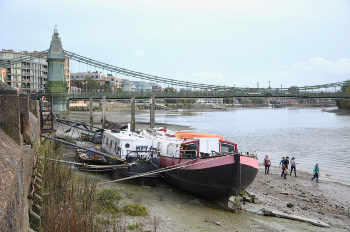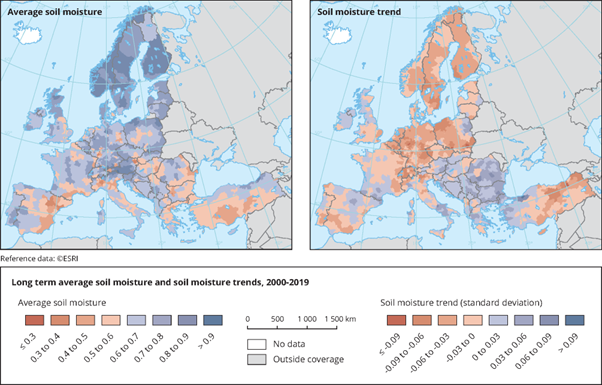Environment Focus
An environmental lens on policies for better lives
How are European cities addressing climate change-induced water scarcity?
By Sophie Lavaud, Simon Touboul and Catherine Gamper, OECD Environment Directorate

Just as we thought we could get out of an unprecedented global drought that marked the year of 2022, the world continues to face a ferociously dry summer. Spain is struggling with the impacts of never-ending drought conditions: since 30 months droughts have led to unprecedented water restrictions, conserving the limited stock of water reserves only for households and selected agricultural and industrial uses. Low groundwater levels have led bottled potable water producers to close down facilities and suppress jobs in France. Entering an El Niño period worsens the prospects of relief in the couple of years ahead. As droughts impact water supply, they can generate water scarcity risks if water demand is left unchecked.
Water scarcity poses particular challenges in cities
Water scarcity risks are particularly daunting in large metropolitan areas. Today nearly 1 billion people are estimated to be exposed to urban water scarcity risk. This is expected to at least double by 2050, going from one third to nearly half of global urban population. In May 2023 the OECD gathered policy makers from Paris, Barcelona, London and the Netherlands to facilitate an exchange on the growing challenge of urban water scarcity risk.
With an oceanic climate, Paris has been spared from water scarcity so far – although increased rainfall variability, higher temperature-induced evaporation, as well as depleting groundwater levels are rapidly changing this historic legacy. The city has relied on its water storage capacity, especially long-established groundwater reservoirs, to bridge spells of droughts. However, climate projections are casting doubt on Paris’ ability to withstand future variability in precipitation rates and temperature changes.
London may be perceived as equally spared from water scarcity issues. Yet, on a closer look, London appears to be drier than Rome or Malta. London has suffered from major droughts over the past 15 years, which has exerted significant pressure on its water supply. The 2022 drought forced London authorities to temporarily ban hosepipes. Thames Water, the largest water services company in the United Kingdom, estimates that severe drought measures and associated water restrictions could cost the London Metropolitan area up to GBP 330 million per day. With both climate change and population growth projected to intensify the city’s drought risk exposure, it is not surprising to see the City of London putting water scarcity risk at the centre of its Adaptive Pathways Strategy that lays the foundations of the city’s climate adaptation strategy.
Similarly, Barcelona has experienced severe droughts over the past 70 years, with the worst unfolding in 2023, where authorities suggest heading into a drought emergency early this autumn after restricting water use for months. At the time of writing this blog, the reservoirs supplying water to the city are as low as 10% of their capacity, threating to contaminate water by silt. In 2008 water had to be shipped to Barcelona by tankers from the south of France to cover basic needs.
The Netherlands, known as being concerned by flood risks in the past, is now confronted with lower average rainfall in certain periods of the year, which has led to lower river waterflows in the Rhine and Meuse Rivers and an increased dryness of soil. Such drought episodes are currently projected to occur every 5 years by 2050 in the worst-case climate scenario. This explains why the National Delta Programme on Fresh Water Supply has made resilience to water shortage its priority for 2050.
Figure – Average soil moisture and soil moisture trends in Europe

Source: https://www.eea.europa.eu/data-and-maps/figures/long-term-average-soil-moisture
How can cities address water scarcity?
The discussions at the International workshop on building urban resilience to climate change-induced water scarcity risk brought about four key actions cities should take in addressing water scarcity risks:
- Carry out scenario planning to address climate uncertainty
To tackle the considerable complexity involved in resilience planning given uncertainty in both climate change and socio-economic trajectories, adaptive planning is a useful tool. Grounded in the elaboration of different scenarios to reflect possible, but uncertain, development pathways, adaptive planning can contribute to informing decision making today. As part of its adaptive planning, London identified around 1 400 measures to be implemented in 9 different climate scenarios, highlighting the importance of reviewing the measures regularly to adapt to evolving realities.
- Incentivise efficient water use to reduce water consumption
Over the past 25 years, Barcelona has reduced its water demand by 30% -consuming around 102 liters per inhabitant per day – compared with 120 liters in Paris or up to 420 liters in Los Angeles. Awareness raising campaigns on saving water as well as regulations such as the installation of reuse systems have contributed to these significant achievements.
- Tap into nature-based solutions to address drought risks
Barcelona established a Sustainable Urban Drainage System (SUDS) Commission to fosters their use. For example, in the Bon Pastor district of Barcelona, individual houses have been replaced by taller buildings, leaving space for green spaces rehabilitation. The construction of hollow gardens has facilitated the collection and drainage of rainwater. Reproducing the natural behavior of water run-off provides water quality and quantity benefits and strengthens the resilience of the city to water scarcity and floods. Similarly, London identified 200 catchment and nature-based solutions to strengthen water ecosystem resilience and allow for sustainable water abstraction.
The results from this international workshop inform ongoing work of the OECD that seeks to evaluate the Paris Metropolitan Area’s exposure and vulnerability to climate change-induced water scarcity risk. It will seek to identify avenues for Paris to continue being resilient to water scarcity risks under future changing climatic conditions.
Further reading
Further reading, please visit our websites:
Photo credit: Shutterstock / Ron Ellis
